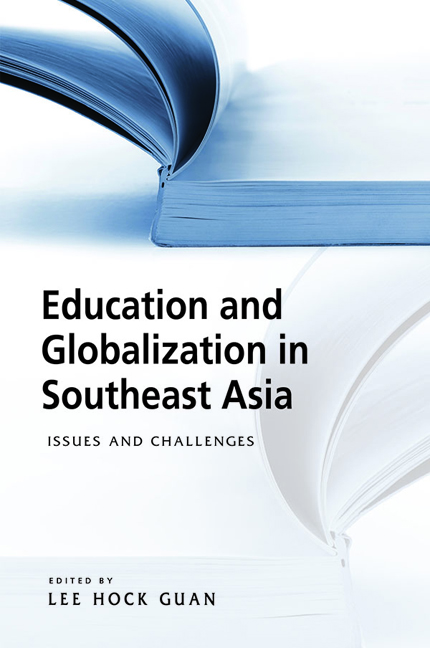Book contents
- Frontmatter
- Contents
- Acknowledgements
- Contributors
- Introduction
- 1 English in Singapore and Malaysia: Common Roots, Different Fruits
- 2 Globalization, Educational Language Policy and Nation-Building in Malaysia
- 3 Second-Order Change Without First-Order Change: A Case of Thai Internationalization of Higher Education
- 4 Higher Education in Malaysia: Access, Equity and Quality
- 5 Indonesian Higher Education: Gaps in Access and School Choice
- 6 Increasing Access to and Retention in Primary Education in Malaysia
- 7 Primary and Secondary Education in Myanmar: Challenges Facing Current Reforms
- Index
6 - Increasing Access to and Retention in Primary Education in Malaysia
Published online by Cambridge University Press: 12 January 2018
- Frontmatter
- Contents
- Acknowledgements
- Contributors
- Introduction
- 1 English in Singapore and Malaysia: Common Roots, Different Fruits
- 2 Globalization, Educational Language Policy and Nation-Building in Malaysia
- 3 Second-Order Change Without First-Order Change: A Case of Thai Internationalization of Higher Education
- 4 Higher Education in Malaysia: Access, Equity and Quality
- 5 Indonesian Higher Education: Gaps in Access and School Choice
- 6 Increasing Access to and Retention in Primary Education in Malaysia
- 7 Primary and Secondary Education in Myanmar: Challenges Facing Current Reforms
- Index
Summary
INTRODUCTION
Access to and quality of education have been key agendas of the Malaysian government to foster national unity and enhance economic growth. The First Malaysia Plan (1966–70) and the subsequent plans give much importance to education: “unless the education system is geared to meet the development needs of the country, there will be a misallocation of an important economic resource, which will slow down the rate of economic and social advance” (Government of Malaysia 1965, p. 163). The government allocates substantial financial resources to education annually, constituting about 17 per cent of the total public expenditure.
The Malaysian Ministry of Education has worked closely with state and district education offices, international organizations (e.g., United Nations Children's Fund (UNICEF) and United Nations High Commissioner for Refugees (UNHCR)), and non-governmental organizations (NGOs), such as Child Aid Borneo and Human Rights Commission, to expand access toprimary schooling to all children. However, access to education remains lower for children who are poor, live in remote and sparsely populated area and without citizenship documentation. It should be noted that children without citizenship documents are not captured in the calculations of Net Enrolment Ratio (NER), and thus represents an additional population of out-of-school children and youth.
The following sections will discuss patterns of primary school access and retention, quality and equity in Malaysia, and policies affecting access and retention in the sector.
WHAT HAS BEEN ACHIEVED?
Patterns of Primary School Access and Retentionin Malaysia
Figure 6.1 shows the primary school NER for selected years (indicated by dots) between 1970 and 1972 as well as between 1994 and 2005. This rate measures the proportion of children aged 7 to 13 who were enrolledin primary school. One notes that this rate was already relatively high in 1970 (84.3 per cent) and had increased to 96.2 per cent in 1994. Between 1999 and 2005, although minor fluctuations occurred, the percentage of primary school-aged children enrolled remained at or above 95 per cent but did not reach 100 per cent (with the highest net enrolment of 97.8 per cent, recorded in 2000). It is important to note that the figures — both the numerators and denominators of these percentages — exclude undocumented children (e.g., those whose parents are refugees or migrant workers), who face special challenges in gaining access to public schools.
- Type
- Chapter
- Information
- Education and Globalization in Southeast AsiaIssues and Challenges, pp. 142 - 165Publisher: ISEAS–Yusof Ishak InstitutePrint publication year: 2017



